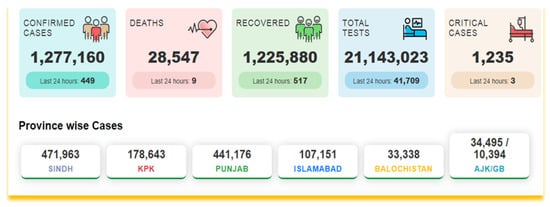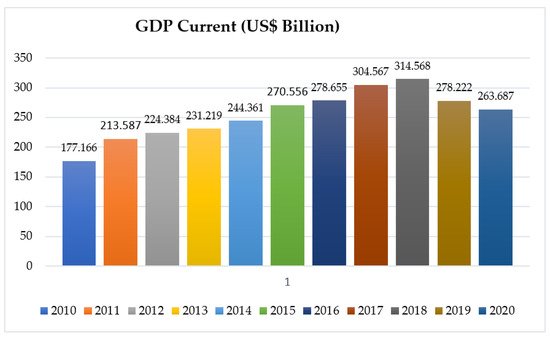The eruption of COVID-19 has jolted the national and international economy. Pakistan is included, causing millions of people to stay at home, lose their jobs, and suspend or end business operations. Unemployment in Pakistan has reached nearly 25 million people, driving many towards conditions of hunger and poverty as the major economic damage in several sectors is anticipated at around PKR 1.3 trillion. The hardest-affected sectors comprise industries such as tourism and travel, financial markets, entertainment, manufacturing, etc., having a devastating effect on gross domestic product (GDP). It is mainly daily-wage earners and people running small businesses that have been seriously exploited and subjected to a curfew-like situation.
1. Introduction
Figure 1 below illustrates that the COVID-19 pandemic entered Pakistan on 26 February 2020, when an undergraduate returned from Iran to Karachi. By 18 March, each of the four regions, (the two autonomous regions), and Islamabad’s government region had reported coronavirus cases. Meanwhile, more than 1,277,160 patients were confirmed by 8 November 2021, in Pakistan. However, Punjab had the most victims, with 441,176 reported, while Khyber Pakhtunkhwa suffered 178,643 casualties as of 8 November 2021. Nonetheless, after the partial lockdown, according to the government of Pakistan’s official portal, there are a total number of cases of 1,277,160 and 28,547 deaths. It is obvious the cases and death rates are increasing rapidly. As a result, in order to save the country’s economy, new strategies and policies must be implemented.
Figure 1. Cases of coronavirus in Pakistan. Source: [
34].
Around the world, Pakistan’s economy is struggling in a severe downturn. COVID-19’s impacts on Pakistan’s economy could result in a sharp drop in GDP growth [42], a skewed current and fiscal balance, disrupted supply chains, and increased unemployment across the board [37]. Several macroeconomic effects are explained in more detail below in Figure 2, considering these issues.
Figure 2. Several macroeconomic factors that impact Pakistan’s economy. Source: author’s development.
2. Spillover to Gross Domestic Product (GDP)
The worldwide pandemic has resulted in national output falling by 2% below the benchmark for the world. It is estimated that the manufacturing and technical sectors contribute 2.5% and 1.8%, respectively, to the national GDP. Surprisingly, local administrations were affected by the pandemic [
10]. The global epidemic is anticipated to decrease China’s GDP by 3.7% and Pakistan’s GDP by 4.64% [
38]. Subsequently, China’s falling GDP has had “knock-on” effects on Pakistan’s total aggregates because both countries exchange in trade [
44]. The authors [
45] reports that a fall in GDP leads to a subsequent decline in business (and capital), prompting lower manufacturing and productivity, lower import–export, and an across-the-board reduction in families’ livelihoods, employment, and take-home pay. The total national output in Pakistan was worth USD 320 billion in 2019 [
46], and the GDP was estimated to be 0.26% of the world [
47]. In
Figure 3, the bar chart estimates that GDP was expected to cause a 10% economic loss (estimated at PKR 1.1 tri.) during the last quarter (April–June 2020) of the 2020 financial year. As calculated by PIDE, if imports and exports fell by 20% during the epidemic, a 6.64% loss was observed in Pakistan’s GDP [
48,
49].
Figure 3. GDP of Pakistan. Source: [
49].
3. Spillover to Import and Export of Pakistan
At present, Pakistan’s imports have a 2:1 tariff restriction ratio [
47], with oil accounting for 25% of the country’s total import bill [
50]. Recurring companies for individuals dependent on hardware imports, metals such as iron and steel, and other substances imported will almost certainly fail because no one wants to conduct business in the current environment [
51]. Imports decreased by 16.9%, from USD 43,447 million in July–April 2018–2019 to USD 36,091 million in July–April 2019–2020 [
52]. Pakistan is likely to see a decline in imports, which would have an impact on its GDP due to a lack of available materials.
Exports are also an essential aspect of a country’s economy. World trade has dropped by 4.6%. Various economies that now have greater than mediocre global losses of business to the European region include China (9.8%), Hong Kong SAR, Singapore (8.5%), Cambodia (7.4%), the Russian Federation (7.3%), Lao PDR (7.3%), Thailand (6.8%), and the Philippines (6.4%). On the contrary, Europe, Canada, and the United States have been projected to decrease by 4.5% [
10,
53]. Pakistan’s exports of textiles amount to 55% compared to fish, rice, wheat, sports, and mineral fuels [
47]. Exports are undeniably harmed when a pandemic occurs [
51], and a 2.4% decrease means a loss of USD 19,650 million from July to April 2019–2020, compared to the previous fiscal year [
52].
4. The Effect on Remittances and Interest Rates
Remittances represented over 5% of GDP in 2019, and this applied to 66 nations, especially the developing economies [
54,
55,
56,
57]. As indicated by the State Bank of Pakistan [
58], Pakistan’s internal settlements were down 4.4% m-o-m (monthly) by February 2020, at USD 1824 million during the COVID-19 pandemic. During 2020, most remittances sent to Pakistan came from the UAE (USD 388.1 million), KSA (USD 422.0 million), and the USA (USD 333.5 million). Undeniably, these kinds of payments have been a significant boost to Pakistan’s economy for many years, and, overall, USD 1 billion has been sent every month over the last two decades, cresting in the 2018 financial year when settlements were worth approximately USD 20 billion [
59,
60]. The World Bank group [
61] noted that sending remittances may be mainly due to the widespread shutdowns caused by COVID-19 outbreaks and that these financial settlements to Pakistan will decline [
48]. Moreover, the SBP’s Monetary Policy Committee (MPC) amended the benchmark interest rate in March 2020 as financing costs rose by USD 75 billion [
48]. It is observed that losses amounted to USD 150 billion during the pandemic, and, subsequently, the MPC implemented an aggregate rate of 11.0% to combat the problem [
51]. Thus, Pakistan’s economic development in the wake of this global epidemic necessitates more scrutiny.
5. Foreign Direct Investment (FDI) Impact
Since the peak of the 2007–2008 fiscal year, FDI inflows to Pakistan have been relatively low, decreasing from USD 4 billion in 2007 to USD 2.3 billion in 2018 [
62]. Furthermore, FDI inflows increased by 68.3 percent to USD 1.34 billion in the first six months of the 2019–2020 fiscal year (July–December 2019), compared to USD 796.8 million the previous year, owing to the Chinese market’s dominance [
45]. Nonetheless, according to [
59,
63], financial flows were higher near the end of the year as the Pakistani government abandoned its year-long policy of allowing the rupee to weaken against the US dollar. The government’s political vulnerability improved significantly because of the general election in July 2018.
However, the situation has changed due to the pandemic, as many governments have taken severe measures, and Pakistan is no exception [
64,
65]. Additionally, necessary financial arrangements have been made to ensure that the widespread health emergency can be paid for [
66]. As a result, flexibility is critical during emergencies, as subsidiary and parent organizations require access to funds to operate [
67,
68]. Thus, FDI plays a significant role in supporting economies but might significantly threatened by the pandemic’s effects on FDI streams due to the worldwide lockdown.
6. Poverty, Unemployment, and Underemployment
According to the “Employment Trends” report published by the Pakistan Bureau of Statistics (PBS) in 2018, the total labor force in Pakistan stands at 63.4 million, of which vulnerable employment was 26.41 million (41.6%). Vulnerable employment is measured as the proportion of own-account workers and contributing family workers in total employment (poor workers generally dependent on daily wages). These workers are likely to be the largest impacted individuals and could lose their employment due to the COVID-19 pandemic [
69]. The COVID-19 epidemic, according to [
48], led in millions of job losses across the country. Because of the slowdown in the economic activity, which has placed employment in a precarious situation, there was a significant increase in poverty and unemployment [
70]. According to a PIDE report, approximately 12.3 million people are expected to face unemployment under a scenario of moderate restrictions by the government [
48]. According to [
71], this is a proximately 46.3% of the total vulnerable employment and 19.4% of the total employment in Pakistan. Wholesale retail trade is expected to witness the highest layoff of 4.55 million people. Thus, the poverty rate in Pakistan could increase from 23.4% to 44.2%.
7. The Effect on the Travel and Tourism Industry
The tourism industry in pre-COVID-19 times was a worldwide, huge profit-earning industry [
72]. As of late 2019, people’s movements and the travel industry have been stopped by as much as 10.4% of the worldwide GDP, and 319 million people worldwide who work in the travel industry have lost their jobs as of late 2019 [
73]. Remarkably, Pakistan is a varied geographical area, ranging from the coastline to the high mountain slopes of the Himalayas. Pakistan’s travel industry began in 1972, with the creation of a range of services for different parts of the country [
74,
75]. However, in 2012, 46.7 million travelers went to Pakistan, and Khyber Pakhtunkhwa was 19%. During 2004–2011, the travel and tourism industry gradually improved and reached its peak in 2019 [
69]. However, the tourism industry is now largely redundant, and many people will be unemployed because COVID-19 has natural and long-lasting ramifications for social interaction and entertainment.
8. The Effect on the Health Sector
Pakistan’s border provinces were the first to experience the COVID-19 outbreak [
66,
76]. On 26 February 2020, Pakistan’s Ministry of Health reported the first case of COVID-19 in Karachi, followed by Sindh province and Islamabad [
77]. Later, a total of 98,943 confirmed positive cases with 4960 critical mortalities and 2002 deaths were reported by 7 June 2020. To ensure patients’ good healthcare as much as possible, Punjab and KPK allocated more beds—955 and 856, respectively. However, [
78] noted that Pakistan’s current situation is unsatisfactory, requiring further action [
79]. Other than China, the United States, the United Kingdom, and Russia, Pakistan is a developing country that lacks the financial resources to combat the COVID-19 pandemic. Furthermore, it does not have anywhere near enough hospitals and quarantine facilities, which are urgently needed [
79]. Transmission of the virus can only be controlled by updating and disbursing the required medical facilities. For both arrivals and departures, Pakistan needs more screening facilities [
77].
This entry is adapted from the peer-reviewed paper 10.3390/su14031054



